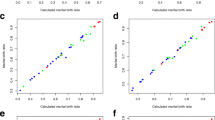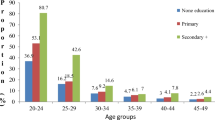Abstract
This paper examines the trends in marriage and fertility in nine countries of southern and eastern Africa using DHS data. First, some background about the age at marriage, age at first birth and the proportion of premarital first births is shown. Next, the total fertility is decomposed into its pre- and post-marital parts. Then, pre- and post-marital fertility are examined in more detail. Finally, the effect of rising age at marriage on the fertility declines is measured. It is estimated that around one sixth to one third of the fertility declines are due to rising age at marriage.
Similar content being viewed by others
References
Blanc, A. and Rutenberg, N., 1990. ‘An assessment of the quality of data on age at first intercourse, age at first marriage, and age at first birth in the Demographic and Health Surveys’, in Assessment of DHS-I Data Quality. Columbia, Md: Institute for Resource Development / Macro System, pp. 39–79.
Bledsoe, C. and Cohen, B. (eds), 1993. Social Dynamics of Adolescent Fertility in sub-Saharan Africa. Washington DC: National Research Council, National Academy Press.
Bongaarts, J., 1978. ‘A framework for analyzing the proximate determinants of fertility’, Population and Development Review 4: 105–132.
Bongaarts, J., Frank, O. and Lesthaeghe, R., 1984. ‘The proximate determinants of fertility in sub-Saharan Africa’, Population and Development Review 10: 511–537.
Brass, W. and Jolly, C.L. (eds), 1993. Population Dynamics of Kenya. Washington DC: National Research Council, National Academy Press.
Caldwell, J. and Caldwell, P., 1993. ‘The South African fertility decline’, Population and Development Review 19(2): 225–262.
Cleland, J., Onuoha, N. and Timaeus, I., 1994. ‘Fertility change in sub-Saharan Africa: A review of the evidence’, in T. Locoh and V. Hertrich (eds), The Onset of Fertility Transition in sub-Saharan Africa. Liège: Derouaux Ordina Editions, pp. 1–20.
Coale, A.J., 1967. ‘Factors associated with the development of fertility: an historic summary’, in Proceedings of the World Population Conference, Belgrade 1965. Vol. 2: 205–209.
Cohen, B., 1993. ‘Fertility levels, differentials, and trends’, in K.A. Foote, K.H. Hill and L.G Martin (eds), Demographic Change in sub-Saharan Africa.Washington DC: National Research Council, National Academy Press, pp. 8–67.
Cohen, B., 1998. ‘The emerging fertility transition in sub-Saharan Africa’,World Development 26(8): 1431–1461.
Gage-Brandon, A. and Meekers, D., 1993. ‘Sex, contraception and childbearing before marriage in sub-Saharan Africa’, International Family Planning Perspectives 19: 14–18, 33.
Gage, A.J., 1998. ‘Premarital childbearing, unwanted fertility and maternity care in Kenya and Namibia’, Population Studies 52: 21–34.
Hinde, P.R.A. and Mturi, A.J., 2000. ‘Recent trends in Tanzanian fertility’, Population Studies 54: 177–191.
Jolly, C. and Gribble, J., 1993. ‘The proximate determinants of fertility’, in K.A. Foote, K.H. Hill and L.G. Martin (eds), Demographic Change in sub-Saharan Africa. Washington DC: National Research Council, National Academy Press.
Kirk, D. and Pillet, B., 1998. ‘Fertility levels, trends and differentials in sub-Saharan Africa in the 1980s and 1990s’, Studies in Family Planning 29: 1–22.
Kitagawa, E.M., 1955. ‘Components of a difference between two rates’, Journal of the American Statistical Association 50: 1168–1194.
Laslett, P., 1980. Family Life and Illicit Love in Earlier Generations: Essay in historical sociology. Cambridge: University Press.
Lejeune, A. and Hinde, P.R.A., 1999. ‘The impact of pre-marital fertility, marital fertility and nuptiality on recent trends in Tanzanian fertility’, in The African Population in the 21th Century. Proceedings of the Third African Population Conference, Durban, pp6–10 December, Vol. 2.
Lesthaeghe, R. and Jolly, C., 1995. ‘The start of the sub-Saharan fertility transition: some answers and many questions’, Journal of International Development 7: 25–45.
Letamo, G., 1996. ‘Contributions of the proximate determinants to fertility change in Botswana’, Journal of Biosocial Science 28: 325–338.
Marckwardt, A. and Rutstein, S., 1996. Accuracy of DHS-II Demographic Data: Gains and losses in comparison with earlier surveys. DHS Working Paper 19. Calverton, Maryland, USA: Macro International INC.
Meekers, D., 1992. ‘The process of marriage in African societies: a multiple indicator approach’, Population and Development Review 18(1): 61–78.
Meekers, D., 1994. ‘Sexual initiation and premarital childbearing in sub-Saharan Africa’, Population Studies 48: 47–64.
Reinis, K., 1992. ‘The impact of the proximate determinants of fertility: Evaluating Bongaarts's and Hobcraft and Little's method of estimation’, Population Studies 46: 309–326.
Robinson, W.C., 1992. ‘Kenya enters the fertility transition’, Population Studies 46: 445–457.
Rutenberg, N. and Diamond, I., 1993. ‘Fertility in Botswana: The recent decline and future prospects’, Demography 30: 143–157.
Stover, J., 1998. ‘Revising the proximate determinants of fertility framework: What we have learned in the past 20 years?’ Studies in Family Planning 29(3): 255–267.
Van de Walle, E., 1993. ‘Recent trends in marriage ages’, in K.A. Foote, K.H. Hill and L.G. Martin (eds), Demographic Change in sub-Saharan Africa.Washington DC: National Research Council, National Academy Press.
Author information
Authors and Affiliations
Rights and permissions
About this article
Cite this article
Harwood-Lejeune, A. Rising Age at Marriage and Fertility in Southern and Eastern Africa. European Journal of Population 17, 261–280 (2001). https://doi.org/10.1023/A:1011845127339
Issue Date:
DOI: https://doi.org/10.1023/A:1011845127339




